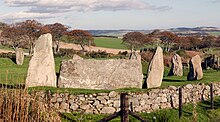Easter Aquhorthies
Easter Aquhorthies stone circle , also East Aquhorthies called, is a stone circle type Recumbent Stone Circle (RSC). Easter Aquhorthies is about four and a half kilometers west of Inverurie in Aberdeenshire , Scotland .
description
As usual for circles of this type, the individual standing stones are selected according to their size (1.7–1.1 m) and color. The circle has a diameter of 19.5 m. Eight of the stones are made of pink porphyry , the ninth is made of red jasper . The two tall stones that flank the lying stone are made of gray granite and the large resting stone itself is made of red granite.
The stone circle is one of the most beautiful examples of the Recumbent Stone Circle type in Aberdeenshire, not least because of its location. When Adam Welfare of the Royal Commission on the Ancient and Historical Monuments of Scotland (RCAHMS) carried out a survey of the facility in 1998, he was surprised by its good state of preservation. As an original example of a stone circle with a lying stone, it could be between 3500 and 4500 years old. However, it is difficult to determine the exact age of stone buildings and depends on finds that can be assigned to the epoch in which the building was erected. As a rule, the remains of a burial site can be found in the middle of such a circular complex in Scotland, which can be used for dating. However, only a small hill 25 centimeters high can be seen here, slightly offset from the center of the circle. This one could be the rest of a cairn. The complex appears to be undisturbed, but has not yet been excavated. Monuments in this area marked on old maps, which were supposed to be identical to the stone circle, showed some contradictions to the situation that Welfare had found. So on some maps only ten stones were to be seen instead of the current twelve. On some old maps the horizontal block flanked by two upright stones was also missing.
Easter Aquhorthies is not to be confused with the Aquhorthies complex , located in Banchory on the left bank of the Dee .
The stone circles on the River Dee
There are nearly 100 Recumbent Stone Circles in the Grampian area of Aberdeenshire, particularly on the River Dee . A characteristic of the RSC is a "lying stone" accompanied by two standing, high, often tapering "flank stones" that are located within the circle or near the circle. The Deeside Stone Circles form a group of Recumbent Stone Circle (RSC). The original and often well-preserved systems were built between 2500 and 1500 BC. In Aberdeenshire. The "lying stones" are usually in the southeast and (usually) on the course of the ring and give the impression of a table or altar.
Individual evidence
- ↑ a b Adam Welfare: Great Crowns of Stone. The Recumbent Stone Circles of Scotland. Published by the Royal Commission on the Ancient and Historical Monuments of Scotland, 2011, pp. 345-349.
- ^ Aubrey Burl: A Guide to the Stone Circles of Britain, Ireland and Brittany. Yale University Press, 2nd Edition, 2005, p. 100, ISBN 0-300114060 .
literature
- Anna Ritchie, Graham Ritchie: Scotland. To Oxford Archaeological Guide . Oxford University Press, Oxford 1998, ISBN 0-19-288002-0 , ( Oxford archaeological guides ), pp. 139-140.
- Adam Welfare: Great Crowns of Stone. The Recumbent Stone Circles of Scotland. Published by the Royal Commission on the Ancient and Historical Monuments of Scotland, 2011, pp. 345-349.
- Aubrey Burl: A Guide to the Stone Circles of Britain, Ireland and Brittany. Yale University Press, 2nd Edition, 2005, p. 100, ISBN 0-300114060 .
Web links
Coordinates: 57 ° 16 ′ 38 " N , 2 ° 26 ′ 44" W.



